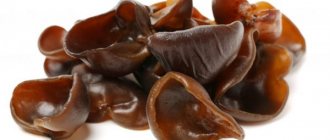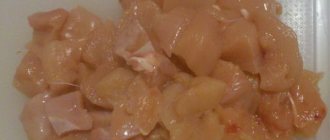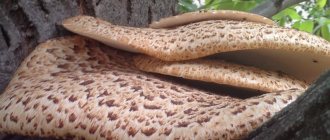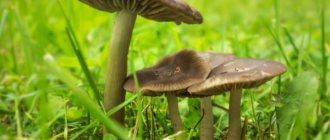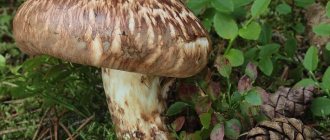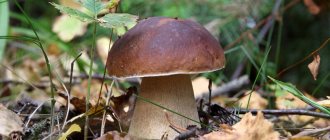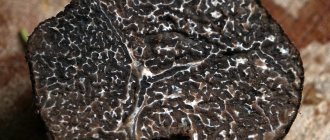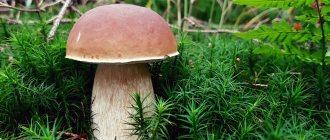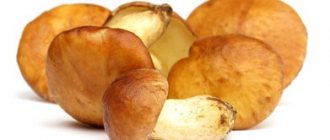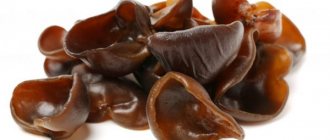Auricularia is a representative of cap mushrooms, which has several varieties. This tree mushroom is classified as conditionally edible because of its not too refined taste. Gourmets will most likely not appreciate the crunchy gelatinous structure, vaguely reminiscent of cartilage, but auricularia has gained great popularity among representatives of the medical community around the world. The substances and elements that this mushroom contains have a pronounced anti-inflammatory and antitumor effect, and the first mention of the use of the mushroom for medicinal purposes dates back to the 16th century [1]. Auricularia has several subspecies: densely hairy, ear-shaped and membranous, while the last subspecies does not have valuable medicinal properties. They are all tree dwellers and have both common and distinctive features.
Judas ears
Auricularia ear-shaped - a delicate oriental delicacy
Oriental, Asian cuisine is an inexhaustible treasure trove of all kinds of miracles and oddities. Asian chefs not only create dishes with amazing flavor combinations, but also often use ingredients for their preparation that a European would never even think of using for food. This, to a large extent, applies to the amazing tree fungus called Auricularia auricula Auricularia auricula , from the genus Auricularia, family Auriculariaceae.
In fact, our people are not stupid either; this mushroom is found here and there in Russia, and experts collect it and, with success, feast on it. However, the mass popularity of Auricularia, precisely as an edible mushroom - a delicacy, came to Russia relatively recently, along with the spread of oriental cuisine.
Auricularia auriculata – a delicate oriental delicacy
Auricularia has many names. The Chinese call it “Black Tree Ear”, the Japanese call it kikurage “tree jellyfish”, and in European countries the name “Judas Ears”, reflected in the scientific Latin name, has stuck. Why? A work of folk imagination. The fruiting bodies of this mushroom really look like auricles, and very often grow on the trunks of elderberries, on which, according to one of the Christian legends, the evangelical traitor hanged himself. The mushroom, of course, is not to blame for anything, but the name stuck.
Auricularia auriculata – a delicate oriental delicacy
History of the name
This species was first mentioned in the scientific literature as Tremella auricula by Carl Linnaeus, then the species was described by Jean Baptiste François Pierre Boulliard as Tremella auricula-judae.
In 1888, Joseph Schroeter gave this species the name Auricularia auricula-judae. The specific name of A. auricula-judae includes auricula, the Latin word for ear, and Judae, meaning Judas. According to binomial nomenclature, a species name can only contain two words; but the taxonomists responsible for this naming added a hyphen to "change the rules" and keep the name "within the letter of the law." However, Auricularia auricula-judae is the currently accepted name for the species, although Auricularia auricula is still used from time to time.
Appearance
The fruiting body has the appearance of a peculiar gelatinous mass, taking the shape of a semicircle, eccentric funnel or auricle up to 10 cm in size.
Its outer surface is covered with small, sparse hairs and is rough to the touch. The inner surface, where the spore-bearing layer is located, is glossy, smooth and darker than the outer one. White spore powder.
The color of the fruiting body strongly depends on age - from translucent or pinkish in young specimens, to dark red, even black, in mature ones. The weather also greatly affects the color - during rains the color darkens.
Auricularia auriculata – a delicate oriental delicacy
The pulp is gelatinous, translucent and thin, without a distinct odor. With age it hardens, darkens and dries out. When dried, it shrinks greatly.
Distinctive features of the ear-shaped auricularia or “ear of Judas”
Like its closest relatives, this subspecies of the fungus is shaped like the human organ of hearing. The similarity in comparison with the densely hairy auricularia is also increased due to the color of the cap: it can be gray-brown or reddish-brown in dry weather, and after rain it becomes dark olive or yellow-brown. Its diameter ranges from 5-10 cm. The cap is attached to the trunk sideways and is shaped like a shell, and also has veins and cells. The cap flesh is 2-3 mm thick. It is odorless and has a gelatinous consistency.
Where and when does it grow
Auricularia auriculata - a delicate oriental delicacy
Auricularia auriculata grows on very weakened or dead trunks of deciduous trees, especially often on alder and elderberry. Prefers to live in deciduous forests with high humidity. Found in small groups or singly. This mushroom is widespread in the warm part of the northern temperate zone, growing in Eurasia from Western Europe to the Far East. In Russia it is found in the southern regions, in the Rostov Region, Krasnodar Territory, and the Caucasus.
Fruits from the end of March until the coldest weather. Tolerates light frosts very well. In Asian countries it can be found all year round.
Collection rules
On the territory of the Russian Federation, auricularia is collected in winter. It is clearly visible on trunks and branches without foliage. The rules for collecting mu er do not differ from the traditional reminder for lovers of “silent hunting”:
- There are many types of tree mushrooms, some of which are inedible. Before going into the forest, you need to read the description and photo of auricularia so as not to confuse the species.
- You should not collect fruiting bodies in bags; it is better to carefully place them in a basket.
- You can take dry specimens, which after soaking will acquire their original appearance and structure.
- The best time for “silent hunting” is morning.
By following simple recommendations, you can stock up on healthy mushrooms even in winter.
A characteristic feature of the species is that it grows in groups, allowing you to collect a large basket in a short time
Culinary Meaning
In Asian, especially Chinese, cuisine, Auricularia auricularis is a valuable delicacy, a necessary ingredient in the Chinese Black Mushroom soup.
Auricularia is successfully boiled and fried, used in salads and marinated with hot spices. Residents of southern Russia boil this mushroom, cut it into strips, mix it with Korean seasonings and get a signature snack.
Auricularia can be dried very successfully. Dried fruit bodies lose a lot in volume, but they are stored very well, and after soaking they restore their structure.
In some sources, this mushroom is positioned as conditionally edible, but it is known that its pulp is quite suitable for eating raw, so it is quite fair to classify it as a full-fledged edible mushroom.
Benefits and harm to the body
The nutritional value of auricularia is very high. The pulp contains:
- protein;
- carbohydrates;
- macro- and microelements;
- a whole range of vitamins.
Auricularia is rich in vitamin B, calcium, silicon, magnesium.
Thanks to this composition, the mushroom is used not only in cooking, but also in medicine. There is historical evidence of the use of an infusion of fruiting bodies to treat the eyes and throat. There are many recipes with heimuerne not only in folk medicine, but also in traditional medicine. They work in case of poisoning as enterosorbents, restoring the vitality of the body after radiation and chemotherapy. Very good results were recorded in the presence of allergic manifestations, increased body weight, and decreased metabolic rates. There is information about the anti-inflammatory, hemostatic, analgesic effects of the fungus.
However, like any remedy, auricularia has contraindications for use for medicinal purposes. These include:
- The period of pregnancy and feeding the baby.
- Children's age is up to 10 years.
- Individual intolerance.
Important! Before taking medicinal infusions, you must consult a doctor.
Beneficial features
The Auricularia Uchiforma contains many very useful substances - protein, amino acids, iron, calcium, phosphorus, saccharides. This mushroom contains many important vitamins - riboflavin, thiamine, carotene, nicotinic acid, vitamin C, as well as lecithin, cephalin, ergosterol, sphingomyelin.
Auricularia also contains food cellulose, chitosan and a complex of polysaccharides - poliose, which has an immunomodulatory effect and prevents the absorption of fats and carbohydrates. The substances contained in the mushroom promote the process of dissolving kidney and liver stones and prevent blood clots.
How to choose and store muer correctly
Most often, mushrooms are sold dried in oriental spice stores at quite reasonable prices. It is important that they are dry, without moisture on the packaging. A smooth black or dark gray color is considered ideal. But most often light varieties come across on sale. The product is unusable if white and green spots are visible. Most likely, at some stage of packaging or transportation, moisture got into the bag and mold formed.
When storing dried mushrooms in a dry place, the shelf life can reach 5 years. If, after preparing dishes, there is a certain amount of soaked muer left, it is advisable to use them within 2-3 days.
We recommend reading:
enoki mushrooms: description, benefits and harms, application
Read
In folk medicine
Auricularia auriculata is a delicate oriental delicacy.
In Asian medicine, this mushroom has long been used for:
- Removal of kidney and liver stones.
- Fighting the formation of blood clots.
- Prevention of hypertension.
- Removing toxins from the body.
- Fighting cancer.
- Combating diseases of the pancreas.
- Restoring blood circulation.
- Preventing heart disease.
- Reducing blood cholesterol levels.
- Slows blood clotting.
- Fight against intoxication of the body.
- Fight skin diseases.
- Treatment of hemorrhoids.
- Helps with acute poisoning, as a substitute for activated carbon.
For treatment, decoctions, alcohol tinctures and infusions of dry Auricularia powder are used.
The high content of antioxidants and various biologically active substances allows this mushroom to be used as a means to restore immunity in chronic diseases and to improve blood composition.
In powder form:
Half a heaped teaspoon, 20 minutes before meals, three times a day, washed down with clean water. Course 2-3 months.
As a vodka tincture:
Half a tablespoon, three times a day, 20 minutes before meals.
There are no official contraindications for the use of this mushroom, but if you want to use it as a medicine for any serious diseases, you should definitely consult your doctor first.
It’s easy to prepare delicious mushroom dishes: proven recipes with auricularia
Delicious dishes with mushrooms are prepared from both fresh and dried products. In the second case, the mushrooms need to be filled with hot water for a while, and they will acquire their original size, taste and shape.
For mushroom soup with seafood take:
- 2.5 liters of vegetable or mushroom broth;
- 1 onion;
- 150 g dried or 250 fresh mushrooms;
- 1 bell pepper;
- 6 medium champignons;
- 150 g fresh salmon;
- 15-20 shrimp.
Onions, peppers, mushrooms and fish are cut into slices or cubes. Vegetables are fried in butter until golden brown. Add prepared vegetables and mushrooms to the boiling broth and cook until tender. 2-3 minutes before turning off, add cubes of salmon and shrimp to the dish. After the soup is removed from the heat, it needs to steep under the lid for 10-15 minutes.
“Chinese Tsai” salad is prepared from boiled chicken fillet, cucumbers, carrots, mushrooms, funchose, soy sauce, specially prepared pancakes and spices. Mushrooms are fried in butter with onions until light golden brown. The chicken is cut into strips, carrots and cucumbers are grated. Funchoza must be boiled first. After mixing eggs and starch, bake pancakes, which are then cut into strips. All ingredients are mixed in a salad bowl, seasoned with spices and soy sauce.
Close View
Auricularia Densely hairy Auricularia Polytricha
Auricularia ear-shaped - a delicate oriental delicacy.
A close relative of our heroine, from the same genus and family. Widely distributed in Asian countries, where it is also considered a valuable delicacy, and is actively grown artificially on wood or a substrate of sawdust, rice husks and cotton husks. The mushroom has a very pleasant consistency and a slightly pronounced taste.
Outwardly, this species is very similar to our heroine, but it is larger - the fruiting bodies can reach up to 15 cm, are lighter in color, and are distinguished by the longer length of hairs on the outer surface.
Auricularia densely hairy lives on tree trunks in deciduous forests of tropical regions of the world. In Russia it is found in Primorsky and Khabarovsk Territories, and on Sakhalin Island.
Auricularia auricularis is one of those funny creations of nature, looking at which is no less pleasant than eating them. We wish you to meet its black and red folded ears during a quiet hunt, and get acquainted with the delicious taste of this wonderful tree mushroom.
Dangerous properties of the Judas ear mushroom
Muer is not toxic. It is impossible to confuse Auricularia auriculata with similar mushrooms, since it does not have poisonous counterparts. The muer tree mushroom can cause harm to the body only if it grew in an industrial zone or other dangerous area and absorbed harmful substances.
Like all mushrooms, “tree ears” are contraindicated for diseases of the liver, gallbladder and thyroid gland. People who suffer from skin diseases should eat Chinese delicacies with caution.
Muer is also contraindicated for children; tree mushrooms should not be eaten by pregnant and lactating women. And even those who are planning to have a child should give up the Chinese delicacy for a while.
Description of Auricularia foliosa
Externally, this gray-brown mushroom looks like a human ear. The diameter of the cap reaches 13-15 centimeters, and the height of the mushroom is 9-10 centimeters. The fruiting body of the mushroom is formed by a large number of intertwined threads. The color of the fruiting bodies is gray-brown with an olive-yellow tint, and over time the color becomes gray. The mushroom is covered with hairs, so it gives the impression that it is plush. Since the fruiting body of Auricularia densely hairy is strong, it belongs to macromycetes.
Funnel-shaped hat. The edges of the cap are wavy, slightly lighter than the rest of the mushroom. The leg is rudimentary, often it is not expressed at all, it is so small that it is invisible. The color of the stem is the same as the cap.
The pulp is cartilaginous, gelatinous. The color of the pulp is brown, but when dried it turns black. During dry weather, the pulp dries out, and when it rains, it can completely restore its structure. The spores are white.
Places of growth of auricularia densely hairy
Densely hairy auricularia grow in deciduous forests. These mushrooms grow on tree trunks, that is, they are xylotrophs, which means that they feed and exist on trees. It is from the Auricularia dense-haired trees that they obtain all the microelements necessary for life. They settle on the bark, completely growing into it. To do this, mushrooms choose old or dead trees. They are found in forests and parks.
These mushrooms bear fruit from June to October. Auricularia densely hairy feel best in humid and warm weather.
Reproduction of auricularia densely hairy
They retain the ability to grow for 10 years. Mushrooms spread to new places due to the release of a huge number of spores carried by the wind. When spores germinate, hyphae are formed - thin branching threads. From these threads the fruiting body of the fungus is later formed. Mushrooms fully develop in 2-3 months, and they can bear fruit for 5 or more years.
Use in cooking
Chinese mushrooms are both an independent product and an essential ingredient in a large number of oriental dishes. In addition to medicinal qualities, they have many beneficial culinary properties. Their taste is delicate, and their aroma is rich and unusual.
Judas's ear goes well with any food. Boiled or fried, it is included in salads, soups, cold appetizers, meat and fish dishes. In dried form, “tree ears” are used as a seasoning. Since the Chinese delicacy contains few calories, Auricularia auricularis is also used in dietary dishes.
How to cook
The muer tree mushroom has an unusual feature - if you place it in water, it will begin to “grow” and increase almost 10 times in size, and then take on its original appearance. This property of the mushroom should be taken into account when preparing it. Before preparing the tree ears, they must be soaked in water for at least 1 hour. The water is drained several times.
Muer does not require immediate cooking, but can be stored for a short time after soaking. Most often it is sent to the refrigerator for a day or stored for several hours in a cool, dry place.
How to brew
The Judas's ear mushroom requires careful heat treatment, so it should be cooked for at least two hours. When boiled, it should be added to soups and salads. They even fry muer only after they have been subjected to many hours of heat treatment. Dried muers are also boiled; drying the abalone is not enough to put it into a dish in this form. But if you grind them into powder, no heat treatment is required. In this form, “wood ears” are used only as a seasoning.
Interesting cooking recipes
The muer tree mushroom, recipes for which are in every cookbook of oriental cuisine, is wonderful when fried. Most often, muer is sold in a small black package. Before cooking, remove the packaging and place the mushrooms in water. They will soon swell. For frying you will need only 300 g of product.
While the “tree ears” are in the water, they are cut for frying.
- 4 carrots,
- 2 onions
- 2 cloves of garlic.
- Pour vegetable oil into a heated frying pan and fry the vegetables for 10 minutes.
- Then remove the pan from the heat a little and add the mushrooms to it.
- Fill with water, close the lid and simmer for another 2 minutes.
- The dish is ready.
You can season it with sauce or seasoning to taste.
In Korea and China, salad with “wood ear” is often prepared. To do this, fry the red pepper, add a little oil to the pan and add mushrooms. Fry for another 2-3 minutes. Then put it on a plate, add onions, coriander, aromatic herbs and various seasonings to taste. Season the salad with soy sauce or vinegar.
Densely hairy auricularia: how to recognize the “tree ear”
The color of this tree dweller is dark olive or brown on the outside of the cap. Inside it is gray-violet or pinkish-gray. The upper part of the cap has a glossy shine, and the bottom is covered with a thick layer of hairs. The mushroom is a large one - adult specimens reach 14-18 cm in diameter, the height of the cap is up to 10 cm, and its thickness is only a couple of millimeters. The leg often either grows very small and almost invisible, or is completely absent. Visually, the mushroom resembles a human ear, which is why it received the popular name “eared.”
The smell is faintly mushroom, and the consistency of the mushroom pulp resembles cartilage, but has a softer, gelatinous structure. Auricularia tolerates drought well - at this time it simply wrinkles and shrinks, but after the first rain it regains its original shape.
Taste and color
The taste is not pronounced. Various sources consider auricularia membranous to be inedible or edible, but with low nutritional qualities. The stage of development of the fruiting body, as well as the condition and variety of wood on which the mushroom grows, influence the color of the auricularia, ranging from light gray, olive to gray-brown with a purple tint, almost black. The coloring is concentric, has clear zoning with alternating dark and light stripes. The surface texture is velvety, soft to the touch. The edges of the cap are whitish and folded. Sometimes, due to settling algae, a greenish coating appears on the mushroom. The lower spore-bearing side of young auricularia is white and smooth, over time it becomes reddish-brown, wrinkled, and streaked.
English classification of auricles
Historically, auricles have received the greatest popularity and love in the UK. Therefore, despite the fact that now it is not only the British who are engaged in the selection of auricular primroses abroad, the English classification of these primroses, which are promising for breeders, is traditionally used to classify foreign varieties of auricular primroses.
According to the English classification, there are 4 types of auricles:
1.
Show (show “exhibition”) auricles
are the most unusual of the four types. Their flowers, abundantly covered with a white powdery coating (“farina”), sometimes almost entirely, have all known colors and shades: many two- and three-color ones, as well as striped flowers that play with the iridescence of several colors at once. The British themselves grow them only in pots under cover so that precipitation does not damage the unique powdery coating that turns each flower into an elegant souvenir.
Show-aricles, in turn, are divided into groups: - Self (petals of the same color); - Edged (bordered - very richly covered with farina), sometimes they are also divided into auricles with gray, white and green edges; — Fancy (a combination of black, red, yellow and other colors with a green or gray edge); — Striped (striped petals with any color combinations).
Perhaps due to the fact that the entire line has historically been cultivated mainly in winter gardens, unfortunately the show auricula group is most unstable in the open ground. Moreover, the main problem is not even frost, but precipitation, which not only spoils the elegant appearance of auricles, but also causes rotting and death of plants.
All these groups of show auricles in practice turned out to be unsuitable even for the conditions of central Russia. According to available information, almost all varieties of auricular primroses bordered with white and gray fall out; unstable and many are monochromatic (Self). The most surviving auriculae are Striped and Green-edged auriculae. But attempts to introduce them continue.
But the other three types of auricles showed themselves to be quite stable in our conditions, with the exception of some more capricious varieties.
2. Alpin (“alpine”) auricles
. Neat round flowers with a yellow (Gold centred) or light (Light centred) center, followed by a darker zone on the petals, and then a contrasting light edge. Thanks to this, the flowers look tricolor. Many alpine auricles are good not only in color, but also in size. Any colors except green. Varieties of auricular primroses with a yellow center are usually yellow-red-brown in color.
3. Borders (“border” - that is, garden)
auricles
. They are considered the progenitors of all varieties of auricular primroses. The British call them “true auricles.” Now this group usually includes plants with large wavy petals, often monochromatic, quite resilient, as follows from the name of the group and its origin.
4. Double (terry)
auricles
. From semi-double to densely double auricles of all possible colors; Not all varieties, however, have a stable strong terry. Oddly enough, they are no more capricious than the other two groups, with the exception of certain varieties.
How to grow muer at home
Two cuts are made in the beams and prepared by soaking them in water for a week. Then the mycelium of the fungus is placed on these branches. Deciduous trees are suitable for this; muers do not grow on conifers in nature. It is best to use meter-long branches with an average diameter of about 15 centimeters. They are usually planted in spring, in April-May. Mushrooms germinate within three months at an average temperature of 20 degrees. After emergence, it is necessary to move the logs to a place protected from the sun.
If the summer has been humid and warm, the first harvest will appear at the end of the season. Muer can be collected when white pores appear at the bottom of the cap. Under favorable conditions, mushrooms will bear fruit for about 6 years.
